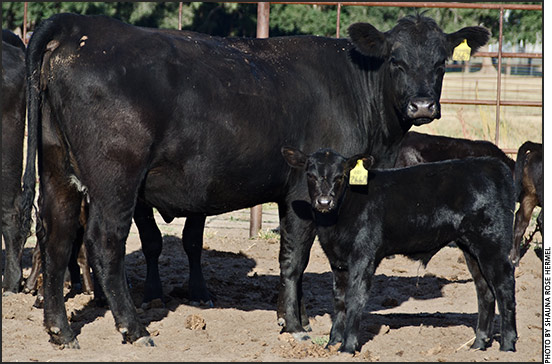
Getting First-calf Heifers Rebred on Time
Veterinarian offers tips to keep first-calf heifers productive in the herd.
It can be a challenge to get first calvers rebred without losing ground. All too often they calve later the next year or come up open. The 2-year-old is nursing her first calf, still growing, and needs good nutrition and body condition to cycle on schedule after calving.
Colin Palmer, associate professor of theriogenology at the Western College of Veterinary Medicine of the University of Saskatchewan, says people still recommend breeding heifers a few weeks ahead of the cows. “Heifers tend to have a longer postpartum recovery period than cows before they start cycling again. To overcome that, some ranchers have the heifers calving about one cycle length (three weeks) earlier than the cows. This gives them more chance to breed back again on time,” he says.
Selecting heifers born early in the season also helps. This not only means they are a little older than the average and more likely to be ready to breed, but also they are offspring of your most fertile cows — the ones that breed early. “You perpetuate fertility, as well as having extra time for them to grow,” he says.
“There are two main things that determine cyclicity in heifers. One is age and the other is body size/condition. Larger body size goes along with older animals, but feeding can also play a role. We used to talk about feeding heifers to reach about two-thirds of mature size before their first breeding season. However, work done by Bart Lardner and Kathy Larson at Western Beef Development Centre looked at feeding heifers to 50%-55% of mature weight, rather than 65%, and found that feeding to 55% was adequate in their Angus-based breeding herd. Their long-term study showed no negative effects, so you can feed heifers to lighter weight if you make sure your feeding program is sufficient to achieve the target,” says Palmer.
He cautions that some on the Extension side are a bit careful about recommending that strategy, because he’s seen many heifers only being grown to about 55% anyway, despite the 65% recommendation, so he worries the industry might try to cut them back too much.
We don’t have to push heifers to 65% of mature body weight by the time they are bred, and we certainly don’t want to overfeed them, he says. “Getting heifers too fat, beyond 2 -pounds-per-day weight gain, can lay down too much fat in the udder and then they won’t milk as well. It’s best to have slow and steady growth in moderation.”
Another thing that can help first calvers is to manage them separately, rather than having them with mature cows for winter feeding or after calving. They don’t compete well with the larger, more dominant cows.
“If a person can’t keep them in a separate group, however, there are ways to manage feed so they have more chance to eat it. If we run first-calf heifers with cows, we try to distribute feed more evenly. Rather than using bale feeders, where there might be a bunch of cows eating on the best bale and keeping others away, we roll out the bale so it’s spread farther. There’s more chance for them all to eat it. We also changed our mineral feeding so that it’s in long troughs rather than just a few tubs,” Palmer says.
It also helps to choose easy-calving bulls for heifers. Their recovery after calving will be quicker if they can calve easily. “If we fail with heifers and they get culled early, they haven’t paid us back yet for our investment. When they come up open after their first or second calf, you’ll only get a cow price for them; it’s not the same as selling a young feedlot animal. It takes four or five calves before a heifer has paid for herself, so you want her to stay in the herd a long time.” It pays to have more intensive management to get her through the critical age as a 2-year-old.

Editor’s Note: Heather Smith Thomas is a cattlewoman and freelance writer from Salmon, Idaho.
[Click here to go to the top of the page.]






